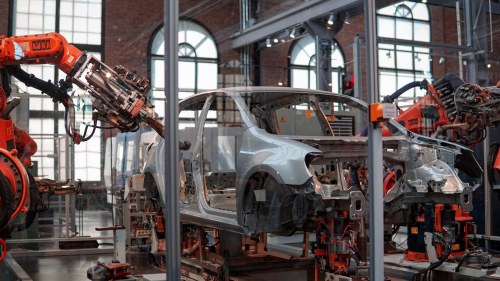Paths to New Prosperity and a Better Politics in Our Democracies

Leaders from the US and Europe have much to learn from one another in building strategies to foster economic renewal in formerly industrial regions.
In 2018 I took a study tour to Germany’s Ruhr region, famous as the historic center of Germany’s coal, steel, armaments, and heavy industrial development. I saw and heard things eerily reminiscent of the experience and attitudes of many residents of my home state of Michigan, where once proud working-class industrial communities have been hollowed out.
I returned and wrote about what we can learn from the German experience, in which over the last 60 years they eased the transition away from heavy low- or no-skill industry and towards a more high-tech and knowledge-driven economy—not perfectly, but demonstrably better than US efforts.
Today, there is a growing convergence of interest and effort on both sides of the Atlantic to bridge geographic economic divides and reconnect residents of rural and former industrial heartland communities to economic opportunity. Where these communities continue to decline, residents feel disconnected and alienated from a rapidly changing global economy and polity.
Where economic regeneration has been done successfully, it serves to return community pride and optimism about the future, which in turn diminishes the appeal of polarizing, resentment-driven, isolationist and ethno-nationalist political movements. These movements undermine our democracies from within and weaken our alliances and democracies’ capacity to counter the rising threat from authoritarian powers such as China and Russia.
But given our cultures and societies in the US and Europe are so different, what if anything can we learn from each other to do this work well?
Much we Can Learn From Each Other
Practitioners of industrial transition should make the most of the variance in US and European contexts and approaches—learning from each other how to do similar things well, as well as how to animate policies and practices borrowed from abroad. For example, there is a strong entrepreneurial spirit in the US, with facility in bringing stakeholders together to develop material projects and respond quickly to change—approaches and processes that can be better understood and deployed in Europe.
Meanwhile, the EU cluster-based and region-based organizational and policy frameworks can provide models for more stable and organized regional development for industrial transition regions. More in-depth comparative analysis of transatlantic approaches and continued cross-pollination of insights and experience can help leaders and economic change practitioners in all regions undergoing an industrial transition better understand “what works” and what lessons can be learned for future strategies.
This transatlantic study tour and other mutual learning exchange activities flagged for participants several topics and ways practitioners on both sides of the Atlantic can learn from each other.
What Europe Can Teach the US
The experience of the EU can show US (and often UK) economic development practitioners how to more effectively do both the straightforward work of sparking new economic activity, and the more subtle but important companion work of improving social cohesion and facilitating democratic participation.
The first and obvious lesson from the European experience is that there are tangible benefits to making a durable policy and investment commitment to place-based economic development, with the application of resources concomitant to the tasks. As the most recent European Commission’s Report on Economic, Social and Territorial Cohesion details: “Over the past two decades, cohesion policy has reduced economic, social, and territorial disparities.”
European regions, with their more robust and durable history of politically and socially organizing efforts to manage regional economic change, can offer models and organizational structures—including around the design and implementation of “smart specialization” strategies, and in getting all levels of political jurisdiction aligned around a regional plan.
As the Ruhr’s Michael Schwarze-Rodrian observed: “We have learned in the last 50 years how relevant it is to mobilize the endogen potentials of a region, a city, and their people. We have also recognized that learning strategies and good solutions have to be tailor-made. The high design-quality of our projects communicates the goals of the transformation. The project qualities are ambassadors of the intended coming developments.”
European communities and regional structural change efforts have a longer history than in the US, including rich experimentation around effective community “green” transformation policy and practice, as both an economic and social development strategy. Not only is there a rich experience base around how to effectively advance policies and practices that support the green transformation, but also in avoiding the politicization of climate change-combatting efforts that has so bedeviled the US.
What the US Can Teach Europe
The study tour and discussions that were part of it provided plenty of material and examples around what the US Midwest’s successful industrial heartland transformation efforts can teach Europeans—efforts much less fully-documented than in Europe, where the EU and OECD have been much more deliberate in sharing best practices and case studies.
The study tour members saw a variety of examples of how the US communities and regions execute coalition-building and forge effective multi-sector public-private partnerships—including how private sector and philanthropic financing can be brought to bear and play both catalytic and supportive roles in a variety of new business and community development initiatives.
The Midwest economic development organizations and institutions demonstrated how to animate an innovative, and entrepreneurial, risk-taking culture even among public sector and educational institutions. And they showed how to translate quickly new technological innovations coming out of universities, medical research complexes, and companies into new commercial products and new companies—including how to organize and apply pools of early-stage and venture capital to support the process.
This fast-moving, results-driven innovation ecosystem included universities and learning institutions that were being leveraged as powerful entrepreneurial agents for economic evolution and change. These institutions also show how learning at all levels could be organized in applied contexts that nurtured individual and community economic opportunity and growth and supported the growth of new jobs.
The US communities demonstrated a variety of ways civic and community institutions, as well as business leadership organizations, can be an effective community convenor and agenda-setter—roles most often in Europe taken by government entities.
While the study tour exposed the challenge faced in the US by a polity being pulled apart by its reliance on wholly different information streams, the travelers were also impressed with the variety of new strategies being developed and deployed in support of better information literacy—a vital foundation for community resident empowerment.
Similarly, while the Europeans were newly exposed to the unique racial dynamics and divides of the Midwest, they were impressed by the current work being done to move and manage economic development specifically to measure and ameliorate social and racial inequities.
Finally, as one participant put it, there was a penchant in the US for “thinking big”—for assuming that big, seemingly monumental tasks could be tackled and accomplished.

